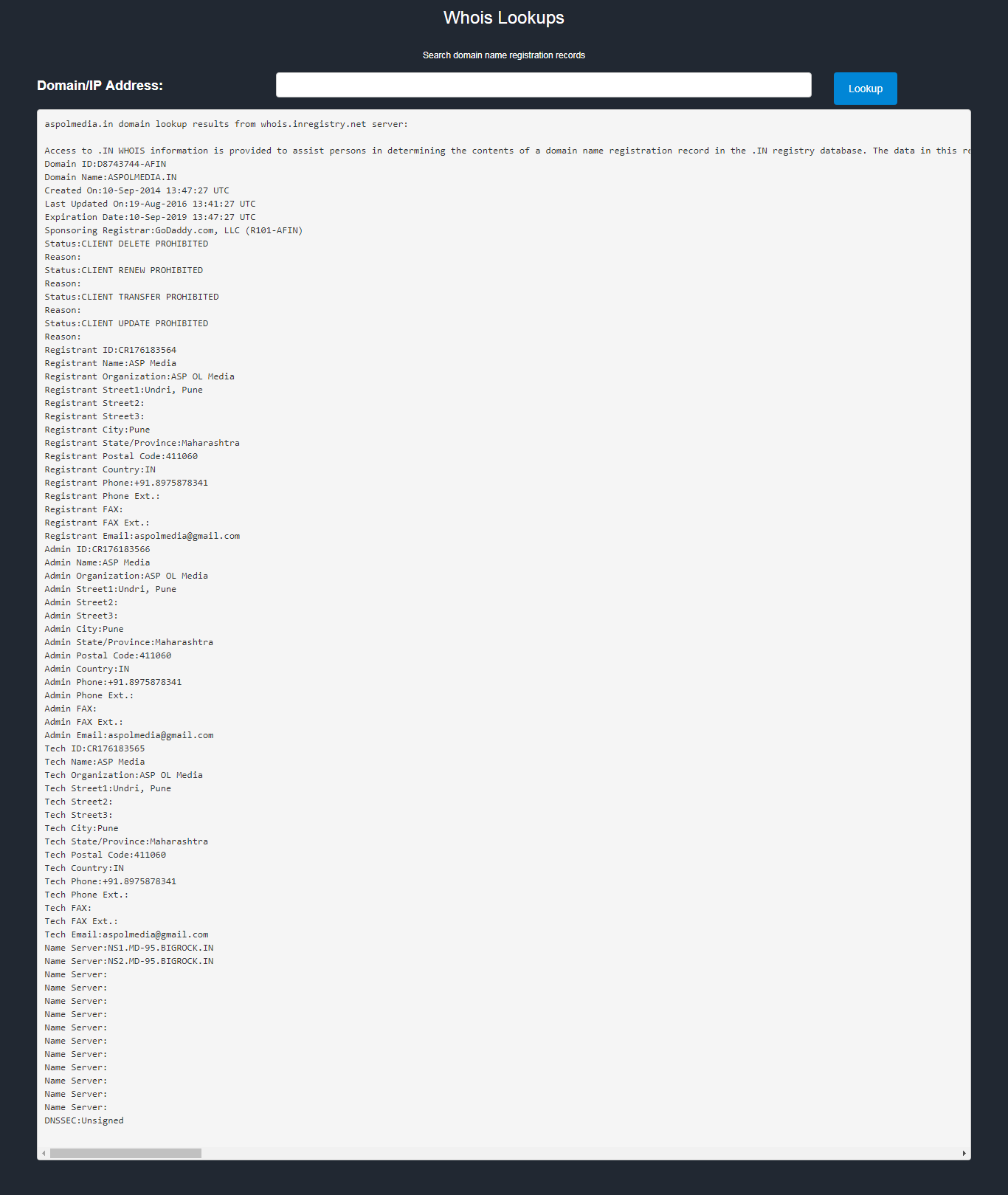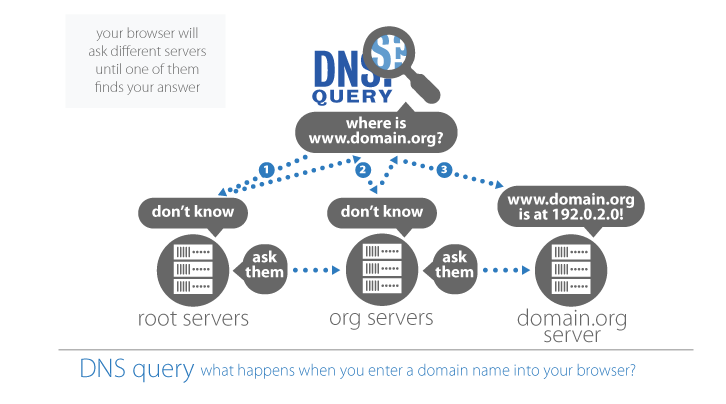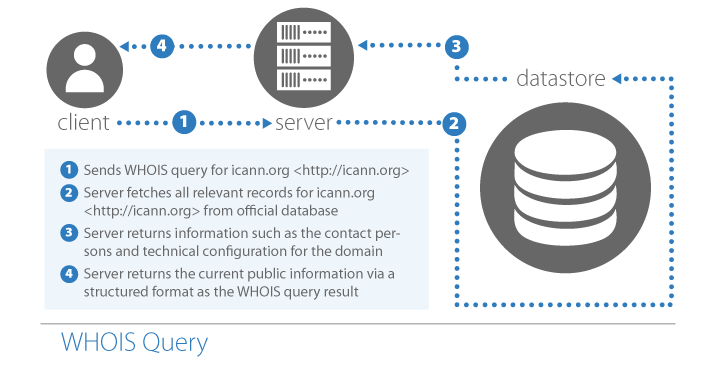Whois Lookup
What is WHOIS?
WHOIS isn't an acronym, though it may look like one. In fact, it is the system that asks the question, who is responsible for a domain name or an IP address?
Every year, millions of individuals, businesses, organizations and governments register domain names. Each one must provide identifying and contact information which may include: name, address, email, phone number, and administrative and technical contacts. This information is often referred to as "WHOIS data." But the WHOIS service is not a single, centrally-operated database. Instead, the data is managed by independent entities known as "registrars" and "registries." Any entity that wants to become a registrar must earn ICANN accreditation. Similarly, registries are under contract with ICANN to operate a generic top level domain, such as .COM, .ORG, or one of the new gTLDs such as .STORAGE and .LINK.
Based on existing consensus policies and contracts, ICANN is committed to implementing measures to maintain timely, unrestricted and public access to accurate and complete WHOIS information, subject to applicable laws. To do that, registrars and registries provide public access to data on registered domain names. Anyone can use the WHOIS protocol to search their databases and identify the domain name registrant.
Domain Name Registrant Benefits and Responsibilities
Domain name registrants play a key role in ensuring the accuracy of WHOIS. As a domain name registrant, you are required to provide accurate WHOIS contact data, and maintain its accuracy throughout the term of your registration period.
When you register a domain name, you must give your registrar accurate and reliable contact details, and correct and update them promptly if there are any changes during the term of the registration period. This obligation is part of your registration agreement with the registrar.
If you give wrong information on purpose, or don't update your information promptly if there is a change, your domain name registration may be suspended or even cancelled. This could also happen if you don't respond to inquiries by your registrar if they contact you about the accuracy of your contact information.
On an annual basis, your registrar is required to send you an annual reminder of your obligation to maintain the accuracy of your WHOIS contact data. Please review the information provided by your registrar in this reminder carefully and make any necessary corrections. If you find that your WHOIS information is inaccurate, please refer to: About Correcting my WHOIS Data.
Depending on the version of the Registrar Accreditation Agreement your registrar has contracted with ICANN organization, there are different rights, benefits or responsibilities that apply to you. For the version of the Registrar Accreditation Agreement applicable your registrar refer to: http://www.internic.net/alpha.html
Here is an example of how does an output looks when you lookup an domain in WHOIS.

DNS and WHOIS - How it Works
WHOIS services are mainly run by registrars and registries; for example Public Interest Registry (PIR) maintains the .ORG registry and associated WHOIS service. ICANN organization coordinates the central registry for Internet resources, which includes a reference to the WHOIS server of the responsible registry as well as the contact details of this registry.
Registries also maintain another vital system, the authoritative name servers, which hold the key to where a website is located. For example, if you type www.icann.org into a browser, your ISP will query the name servers starting from the hard coded root servers to find out which name servers are associated to that domain name. One of those name servers is then contacted and will return the IP address for that domain name. Your computer can now connect to the computer that will serve up the ICANN homepage.

The selection of which registry operator is to be queried each time depends on the trailing part of the domain (e.g. .COM, .NET, .UK), also known as the top-level domain (TLD). If the ISP doesn't already know, it can determine which name server need to be asked for a given part of the domain name, beginning with asking a root server. There are various root servers located all over the world that point to the appropriate downstream name servers.
WHOIS is designed to work in the same way: Starting at WHOIS.IANA.ORG, follow the references to the downstream WHOIS servers unless the required information is obtained. This process is illustrated below for a "thick" registry. If the registry has not yet fully transitioned to "thick" still uses a "thin" data model, an additional process query at the registrar's database is required to obtain the WHOIS data for the domain name.

Using WHOIS
In addition to the WHOIS services offered by registrars and registries, ICANN organization provides a free and publicly available WHOIS look-up tool that can be used to find WHOIS data for any gTLD domain names. The tool searches the databases of registries and registrars and displays the WHOIS data searched, including domain name registrant contact information. The following topics detail how to make use of this WHOIS look-up tool:
Basics of WHOIS
As many consumers use search engines to find information on the Internet, they may not be aware of the term "WHOIS" to use in a search engine. Even when "WHOIS" is applied to a search engine, all sorts of responses appear. Learn more about the Basics of WHOIS.
Performing WHOIS Lookups
ICANN organization has committed to making WHOIS look-ups as easy as possible. To perform a search, users only need to go to http://whois.icann.org, enter a domain name, and click "Lookup."
Interpreting WHOIS Results
The raw WHOIS data is organized by contact data (domain name registrant contact, administrative contact, technical contact, and abuse contact) and also contains information such as the registrar, status of the domain name, and important dates.